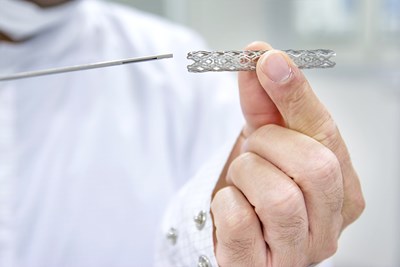Angioplasty is a minor procedure that treats clogged or narrowed blood vessels and arteries. Blockages are a serious problem because they can cause abnormal flow of blood throughout the body and to the heart. If you are at risk for heart attack or heart disease, you may be a candidate for angioplasty.
The most common type of angioplasty uses a balloon catheter. The catheter, which is a long, narrow tube, is inserted through the thigh or arm and guided through blood vessels until it reaches the obstructed artery. The balloon, attached to the tip of the catheter, is then inflated. When the balloon is inflated, the hard plaque deposits are crushed or flattened and the artery will widen and clear, restoring normal blood flow. In 60% to 70% of balloon angioplasty procedures, a small metal device called a stent is inserted to keep the treated artery open.
Recovery at the Hospital
The procedure is relatively short, usually taking between 30 to 90 minutes. After the angioplasty is completed, you will be moved to a recovery room where you will most likely stay for one night. While staying in the hospital, your heart rate, pulse, and blood pressure will be monitored. In order to prevent bleeding, a bandage or a compress may be placed on the catheter insertion site.
After 4 to 6 hours following the procedure, you will be able to walk with assistance. This is one of the main advantages of angioplasty—it is a less invasive procedure than heart surgery, and your recovery time is shorter. If the catheter was inserted through the wrist, recovery is known to be even faster. Some patients are able to go home the same day without a risk of complications, but it depends mostly on the patient. Regardless, you should expect to stay overnight.
Your doctor may also have you attend a cardiac rehabilitation program. The program is administered by a team of health professionals that will offer education and support to assist you in recovery and encourage you to adopt new, healthy habits, such as eating right and exercising. These lifestyle changes are important for keeping your arteries open and heart healthy.
Recovery at Home
You will be discharged from the hospital with specific instructions from your doctor about what you can or cannot do at home. For example, you can expect to be told to avoid heavy lifting and strenuous exercise for the first few days or weeks after the angioplasty. Make sure you leave the hospital with a clear understanding of what medications you need to take, what the signs of an infection are, and when to schedule a follow-up appointment.
If a stent was placed during the procedure, you may experience a mild chest ache. Severe chest pain indicates that there is a problem with the stent in which case this should be handled like an emergency and you should seek medical attention right away.
Medications
To help prevent heart attack, stroke, or the chance of blood clots, antiplatelet medicines will be prescribed for you to take. If a stent was placed during the angioplasty, you will be advised to take aspirin in combination with clopidogrel (Plavix), which is another antiplatelet. Medication may need to be taken for up to one year. Tell your doctor if you have a high risk of bleeding because this risk can affect the duration time of your medications.



